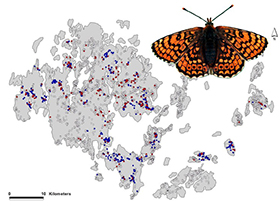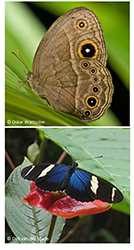The broad aim of our research is to understand the processes and the underlying genetic mechanisms that allow organisms in the wild to cope with environmental variation. |
|
Our main study system is the Glanville fritillary butterfly (Melitaea cinxia) metapopulation in the Åland Islands. This classic metapopulation consists of a network of 100s of local populations that exist in a stochastic balance between local extinctions and re-colonizations. The long-term population level data survey on the occurrence of the butterfly in the dry meadows of the Åland Islands was initiated in 1993 by the late Professor Ilkka Hanski (1953-2016). This long-term data set contains information not only on the occurrence of the butterfly and characteristics of the habitat patches but also on numerous related ecological factors such as host plant density, parasitism prevalence (in collaboration with S. Van Nouhuys), and the prevalence of a pathogen infecting one of the host plant species (Plantago lanceolata; in collaboration with A-L Laine). This data is gathered bi-annually by a group of students from the University of Helsinki (survey organized by MRC). In addition, we now have newly developed genomic tools (genome and a linkage map) which allows us uniquely to synthesize in a multidisciplinary fashion the importance of both ecological and genetic factors influencing life history variation in the wild |
 |
Interplay between ecology and genetics in shaping immunity in natural populations (Academy of Finland and Kone foundation)
This project focuses on the influence of ecological factors, abiotic and biotic, on one of the most crucial traits in all organisms, immune defence. More specifically, we aim to understand whether environmental conditions during different life-stages can work as predictive cues guiding individual's later life immune responses in an adaptive way, whether such responses occur across generations, and what is the influence of immune defence investment on other key life-history traits under semi-natural conditions. Life-history responses are assessed in both control and infected (by bactreial or viral pathogen) individuals. We are using molecular and genomic tools to assess the role of genetic and epigenetic variation in shaping immune defence as a response to developmental stress.
Environmental stress and its effects on life history and resource allocation patterns (ERCStG META-STRESS)
Severity, frequency, and unpredictability of environmental change has increased dramatically in recent years due to human caused phenomena, such as habitat fragmentation, habitat degradation and climate change. Species in the wild are constantly experiencing stress due to this environmental variation, for example when their resource availability becomes limited or they experience sub-optimal temperature conditions. We know from the lon-term data that also in the Åland system the extreme weather events are having increasing impact on the population dynamics. In out META-STRESS project, we combine experiments with simultaneous life-history assessments of individuals in the wild to understand how variation in host plant quality influences life histories of the butterfly. We will integrate the ecological studies with molecular approaches to unravel the significance of different mechanisms – candidate genes, epigenetic inheritance and intestinal microbial communities – potentially influencing individual responses to environmental challenges.
Dispersal
One of the key life-history traits in organisms living in spatially structured populations, including the Glanville fritillary butterfly, is dispersal, as it allows individuals to move between habitats and establish new populations. I have been interested in dispersal and its' influence on other life history traits since the initiation of my PhD. So far, we have shown, for example, the importance of both genetics and environmental factors in shaping individual's dispersal ability. In M. cinxia we have demonstrated how the spatial population structure can greatly influence the evolution of dispersal and other fitness-related traits and how dispersal is tightly linked with variation in a gene Pgi that encodes a glycolytic enzyme phosphoglucose isomerase. I am part of a European level Dispersal working group, which meets every two years to discuss current topics related to Dispersal. In September 2015, together with M. Delgado we organized a meeting on Genetics and Dispersal at the Tvärminne Biological station.
Other study systems
Bicyclus anynana is a sub-tropical African butterfly, which has become an Evo-Devo model system. B. anynana lives in a seasonal environment, characterized by predictable variation in many ecological conditions, including ambient temperature. A key adaptation to such seasonal environmental variation is developmental phenotypic plasticity, where a different phenotype is expressed from the same genotype in response to the environmental cue during development. In a collaborative project with V. Oostra (UCL), C. Wheat (Stockholm University) and B. Zwaan (University of Cambridge) we are using B. anynana to quantify the extent of adaptive phenotypic plasticity across the transcriptome, and to reveal the potential for evolutionary change in such plasticity. Heliconius butterflies are well-known for the ecological and evolutionary studies on mimicry. We are using the tropical butterfly Heliconius sara from Panama, in a collaborative project (with C. Jiggins, University of Cambridge) funded by the Academy of Finland to A. Mattila to study the ecology and genomics of toxicity and how variation in toxicity relates to variation in life history of the butterfly. This research will initiate in the beginning of 2017. |
 |

